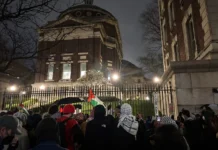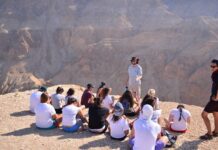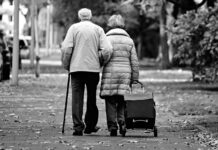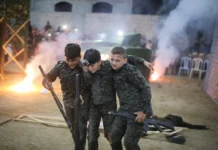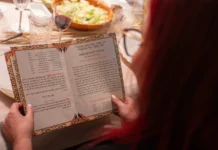Each year, Yom Hashoah brings with it memorial gatherings across the world, candle-lighting ceremonies with elderly survivors and speeches by dignitaries.
Across Israel, the children and grandchildren of survivors publicly read of the names of those who perished. Not to mention the siren that wails for two solid minutes in the morning as pedestrians freeze in place, students stop their learning and workers their tasks, and even drivers climb out from behind the wheel to stand silently with bowed heads.
But this year, Holocaust Memorial Day (April 20-21) is expected to be a quiet event, with the survivors who usually are at its very heart representing the group at highest risk of likely infection and complications from the coronavirus (COVID-19) now in full force across the planet. They are warned to remain confined to their homes, and almost everyone else is limited in their outdoor movements as well.
But instead of being intimidated by the ruthless germ, many of the survivors are surprisingly … calm. “These are the frail elderly—people who are at the highest risk—and most of them are alone without their usual visitors, but amazingly they’re not afraid,” observes Simmy Allen, who heads up international media for Yad Vashem’s communications division. “The survivors are giving us strength.”
In his Romanian hometown, 30,000 Jews, including many of his family, were killed in one day in 1942. “I was only 10 years old, but I remember it all,” says Evron, now 88. To make sure their descendants understand what happened there, the Evrons took the entire family to Eastern Europe in 2005. There they saw his hometown and her family’s fur factory that, despite decades of legal battles, they’ve yet to be compensated for.

So when it comes to the current threat, “we sure have faced more difficult times,” attests Evron. “We were persecuted and massacred, and yet we survived. So I don’t think we have to be afraid of this virus.”
It’s an attitude that their granddaughter, Adi Evron, has discerned since as early as she can remember. “I call them every Friday to see how they’re doing emotionally without family, and their optimistic spirit is an inspiration to me,” says Evron who now lives in Tel Aviv. “Even though I grew up hearing their stories, I could always tell how much they love life and live every minute to the fullest, and my grandfather knows every joke there is.”
‘I am not afraid’
That courage and will to survive—and to help others in the process—is the theme of this year’s Yad Vashem Yom Hashoah online exhibit: “Rescue by Jews: One for All.” By featuring many true-life stories, the exhibit demonstrates that “the Jewish rescuers faced frequent hardships and dilemmas, yet they chose to act on behalf of their fellow Jews.” Its message is a strong one: “It is incumbent upon the Jewish people, and the world, to remember and learn from these amazing deeds.”
The stories included the exhibit, says Allen, “disprove once and for all the stereotype that Jews were like sheep led to the slaughter. There were many, many who risked their own lives again and again to save their fellow Jews.”
Among those whose stories are featured in the exhibit: Fela Trajman is one of the living remnants of Nasza Grupa (“Our Group”), a resistance movement of young people from Poland as clever as they were courageous and determined to save other Jews, risking everything to do so.
Not only did Trajman, her husband Pinek and their compatriots pull Jews out of hiding and transport them to safer ground, they arranged for falsified papers to allow Jews to pass as gentiles and escape, hid the vulnerable when necessary in trustworthy non-Jewish homes, sabotaged German property, smuggled in weapons and delivered warnings to flee across the few open borders when they got wind of upcoming deportations. Of the original 110, some 60 were murdered, often in the line of duty, and most of the 50 who survived the war, including the Trajmans, made their homes in Israel. Fela is one of only five of the original 110 alive today.
“In the ghetto before the deportation, I used to say to anyone who wanted to listen, ‘I will survive and not go to Auschwitz,’ ” she recalls. When deportation was imminent, she walked through the gate and was picked up by a German officer who hid her for three days and helped her escape to join the underground resistance forces. “I always met good people who helped me,” she says. “After I joined them I was able to help others escape, too.”
This same attitude holds Trajman in good stead today. “I am not afraid now because of my past in the Holocaust and in Israel, too.” Her husband again risked his life as a sniper for the Israeli army who was among the unit who conquered Mount Meron during Israel’s War of Independence.
These days, she says, “I’m staying at home alone, and if I have bad thoughts or a bad mood, I laugh and then I feel better. And I believe it will soon be over.”
This approach to new trauma doesn’t surprise Trajman’s daughter, Esti Shevach, who lives not far from her mom outside Tel Aviv. “After all of her losses, it’s that same optimism that I’m sure helped her survive.”
Nor does it surprise Abraham Sagi-Schwartz, professor emeritus at Haifa University and an expert on Holocaust-survivor psychology. His study (along with Marian J. Bakermans-Kranenburg, Shai Linn and Marinus H. van IJzendoorn) of 60,000 survivors in Israel, titled “Against All Odds: Genocidal Trauma Is Associated with Longer Life-Expectancy of the Survivors,” showed that much to everyone’s surprise, they actually live longer than their peers. The results clearly demonstrated this pattern, surprising “given that most survivors not only suffered psychosocial trauma but also malnutrition, restriction in hygienic and sanitary facilities, and lack of preventive medical and health services, with potentially damaging effects for later health and life.”
“So, despite their trauma, despite deprivation, at this stage in their life, they’re managing the corona situation by saying, ‘We will overcome this, too. We will beat the corona,’ ” says Sagi-Schwartz. “It’s their amazing power of resiliency.”

That power is alive and well in fact in the world’s oldest working journalist and radio talk-show host. Ninety-six-year-old Walter Bingham was a teen when, just two years before his father and many of family members were murdered (his mother miraculously survived), he fled from his home in Nazi Germany to England through the Kindertransport (a program that rescued some 10,000 Jewish children) in the summer of 1939.
“We’re not shaking with fear,” he says from his Jerusalem home studio, where he broadcasts his program for Israel News Talk Radio and other outlets. “We’ve gone through a lot in our lives, but I’m as fit as can be—the only pills I take are what old men use to ease the waterworks and some vitamins—so if we do what we’re supposed to do and keep away from people, we’ll get through this, too.”
And, adds Bingham who made aliyah from London at age 80, “with everything we’ve survived, this is not reason to be melancholy. We’ve made it through much worse disasters in our lifetimes.”
‘The light at the end of the tunnel’
But despite their extraordinary courage and resilience, many Holocaust survivors find they’ve lost out on health and other services along with emotional support due to the pandemic. Things the Claims Conference is moving mountains to alleviate.

Not only has the organization, which provides compensation and support for Holocaust victims using both German reparations and private donations, freed up $300 million to help social-service agencies meet pressing needs for survivors, including home health care, and personal protective gear for survivors and caretakers alike, they have established a $4.3 million fund for emergency relief for many of the 400,000 survivors alive today around the world, many of them even more isolated than before in the face of the coronavirus threat.
“Right now, when most of them are alone, we’re 100 percent focused on making sure they are safe and have everything they need,” says Claims Conference executive vice president Greg Schneider.
In the flurry of delivering services where they are most desperately needed, what amazes him most is the questions he has been getting from the survivors, notably, “How are you doing with this, Greg? And how’s your family?”
“They have such a clear sense that they’ve been through the darkest times and experienced the worst pain, and yet were able to rebuild their lives,” he says. “So they see the light at the end of this tunnel, too.”
But not to be overlooked, warns Schneider, is the opposite reaction—that the corona threat can, for many survivors, trigger terrible memories and flashbacks of times when they’ve been isolated, dependent on others, and having to fear scarcity and hoard food. In addition, April is always an emotionally tough time anyway for survivors, he adds. “There’s Passover with its Yizkor service [the Jewish prayer for departed loved ones] and Yom Hashoah bringing back so many memories; these can be emotional bumps in the road even without the pandemic. So this year, when so many of the survivors are all alone without visitors, it’s even harder.”
Still, even with the return of painful memories and even in this day of social distancing, many of them are still reaching out to help others. “One survivor, it was Naftali Furst, called us with an offer last week,” relates Yad Vashem’s Allen. “He said, ‘If anyone feels alone or afraid, just have them call me.’ I can talk to them.”
And they’re also clinging to their unwavering hope for the future—a skill that’s held survivors in good stead for 75 years. Over in Queens, for instance, Jehuda Evron is already planning for next Passover. “Then we’ll do two years’ worth of celebration,” he says with a laugh. “We’ll have a lot of catching up to do.”

